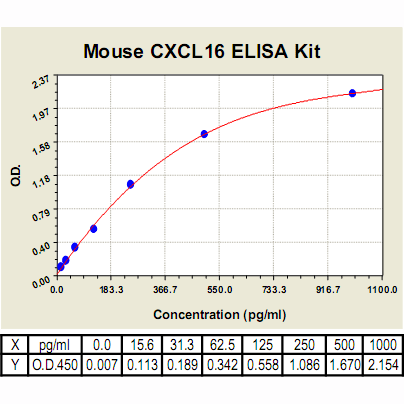Product Sheet CL0742
Description
BACKGROUND The chemoattractant cytokines (chemokines) are ubiquitous chemotactic molecules that play major roles in acute and chronic inflammatory conditions. They are divided into 4 families defined by the number of amino acids between the N-terminal cysteine residues (CC, CXC, CCX, and CX3C). The largest families are the CC and the CXC chemokines. The CXC chemokine family is a pleiotropic family of molecules that are involved in the trafficking of various leukocyte subsets, angiogenesis, and vascular remodeling.1 CXC chemokine ligand 16 (CXCL16), a novel transmembrane chemokine, also functions as a scavenger receptor which can bind and uptake bacteria, dextran sulfate, phosphatidylserine and oxidized lipoprotein (named SR-PSOX). CXCL16/SR-PSOX are mainly expressed in macrophages and dendritic cells. It was also shown that CXCL16 promotes foam cell formation through a tumor necrosis factor (TNF)-α mediated mechanism. Interestingly, as a transmembrane protein it acts as an adhesion molecule. Being similar to fractalkine, it is released as a soluble chemokine after cleaving by proteolytic enzymes ADAM metallopeptidase domain 10 (ADAM10). It strictly attracts CXC receptor 6 (CXCR6) expressing T, natural killer cells (NK), and NKT cells to the sites of inflammation and injury.2 Additionally, it was demonstrated that CXCL16/SR-PSOX can be a potential player in atherogenesis. Initial ex vivo studies showed that CXCL16/SR-PSOX is abundant in human and murine atherosclerotic lesions. Following in vitro studies suggested that as an adhesion molecule CXCL16/SR-PSOX might mediate T-cell adhesion to the endothelium, as a chemokine - drive T-cell migration, stimulate cell proliferation and elicit inflammatory phenotype in smooth muscle cells (SMC) and, finally, as a scavenger receptor - mediate uptake of atherogenic lipoproteins by macrophages and SMC. All these effects are known to be pro-atherogenic. Surprisingly, in vivo studies performed in murine models of atherosclerosis suggested that CXCL16/SR-PSOX is atheroprotective, while its receptor CXCR6 is harmful.3 Moreover, CXCR6 and CXCL16 are up-regulated in multiple cancer tissue types and cancer cell lines relative to normal tissues and cell lines. In addition, both CXCR6 and CXCL16 levels increase as tumor malignancy increases. Trans-membranous CXCL16 chemokine reduces proliferation while soluble CXCL16 chemokine enhances proliferation and migration. TM-CXCL16 functions as an inducer for lymphocyte build-up around tumor sites. High trans-membranous CXCL16 expression correlates with a good prognosis. Moreover, the Akt/mTOR signal pathway is involved in activating the CXCR6/CXCL16 axis. These findings suggest multiple opportunities for blocking the CXCR6/CXCL16 axis and the Akt/mTOR signal pathway in novel cancer therapies.4
REFERENCES
1. Liu, L. et al: Curr Top Dev Biol. 68:149-81, 2005
2. Tabata, S. et al: J Leukoc Biol. 77:777-86, 2005
3. Sheikine, Y. & Sirsjö, A.: Atherosclerosis. 197:487-95, 2008
4. Deng, L. et al: Biochim Biophys Acta. 1806:42-9, 2010
2. Tabata, S. et al: J Leukoc Biol. 77:777-86, 2005
3. Sheikine, Y. & Sirsjö, A.: Atherosclerosis. 197:487-95, 2008
4. Deng, L. et al: Biochim Biophys Acta. 1806:42-9, 2010
Products are for research use only. They are not intended for human, animal, or diagnostic applications.
Details
Cat.No.: | CL0742 |
Target Protein Species: | Mouse |
Range: | 15.6 pg/ml – 1000pg/ml |
Specificity: | No detectable cross-reactivity with other cytokines |
Storage: | Store at 4°C. Use within 6 months. |
ELISA Kits are based on standard sandwich enzyme-linked immunosorbent assay technology. Freshly prepared standards, samples, and solutions are recommended for best results.
Products
| Product | Size | CAT.# | Price | Quantity |
|---|---|---|---|---|
| Mouse CXCL16 ELISA Kit: Mouse Chemokine (C-X-C Motif) 16 ELISA Kit | Size: 96 Wells | CAT.#: CL0742 | Price: $533.00 |

